Stay in the know on all smart updates of your favorite topics.
Moving from a linear to a circular economy means minimising the waste and pollution by reducing, recycling and reusing. The City of Amsterdam aims to redesign twenty product- or material chains. The implementation of material reuse strategies has the potential to create a value of €85 million per year within the construction sector and €150 million per year with more efficient organic residual streams. Amsterdam set up an innovation program on the circular economy; www.amsterdamsmartcity.com/circularamsterdam. By converting waste into electricity, urban heating and construction materials, the Amsterdam Electricity Company generates 900 kWh per 1000 kg of waste. 75% of the sewage system is separated for waste and rain water and the silt which remains after treating waste water is converted into natural gas. Share your innovative concepts and ideas on circular economy here.
Learn more about the smart city with these videos! Edition 3: The Circular City

While most of us are working from home in these surreal times, the Amsterdam Smart City team will support you with some inspiration and learnings about the city. We handpicked videos worth watching!
**Your agenda might still be full with Zoom videocalls or maybe your helping your neighbours with some groceries. Either way, hopefully these videos will be an inspiration and give you some welcoming new insights. Time to check out videos about the development of the city!
We selected these ones about Circularity in the City: recorded in 2019 in Pakhuis De Zwijger, thé dialogue center in Amsterdam.**
16 oktober 2019: De Circulaire Stad (in Dutch)
Hoe bouw je aan een circulaire stad? We kijken we wat er al gebeurt, wat er nodig is om circulaire steden te organiseren en wat wij en de rest van de wereld hier van kunnen leren.
Met ASC partner Metabolic.
[►
Festival Trouw Duurzame 100 2019: De Circulaire Stad
Van de meest duurzame koplopers tot het belangrijkste burgerinitiatief van 2019: de Trouw Duurzame 100 is vernieuwd! Dit vieren we samen met de winnaars van afgelopen jaren met een verticaal duurzaamheidsfestival in heel Pakhuis de Zwijger. Wie wordt het duurzaamste burgerinitiatief van 2019? https](https://www.youtube.com/watch?v=qPNW-xX0Bdo)
27 mei 2019: Amsterdam Smart City - Circulaire Vooruitzichten (in Dutch)
Steden waarin al het afval volledig wordt gerecycled. Het klinkt als een ideaalbeeld, maar hoe komen we daar? En hoe betrekken we bewoners zo goed mogelijk bij de processen die hierbij nodig zijn? Afval kunnen we gebruiken als grondstof voor nieuwe producten, zowel op lokaal als centraal niveau. Tijdens dit programma kijken we naar een nieuw ‘Circulair Innovatiecentrum’ dat in Amsterdam moet komen te staan. Hoe zorgen we ervoor dat grote bedrijven en bewoners zo goed mogelijk worden betrokken bij het nieuwe proces van afvalverwerking? Hoe wordt dit aantrekkelijk voor al deze partijen? En wat kunnen we leren van een Upcyclecentrum van de gemeente Almere?
Met Amsterdam Smart City partners Hogeschool van Amsterdam en Gemeente Amsterdam.
[►
Amsterdam Smart City #4: Circulaire vooruitzichten
Steden waarin al het afval volledig wordt gerecycled. Het klinkt als een ideaalbeeld, maar hoe komen we daar? En hoe betrekken we bewoners zo goed mogelijk bij de processen die hierbij nodig zijn? Tijdens dit programma kijken we naar verschillende projecten rondom circulariteit en afvalverwerking va](https://www.youtube.com/watch?v=B2rdESl2d9I)
14 februari 2019: Future materials – When fake becomes the new real (In English)
Whether it is about vinyl floors with woodprint, marble print on tiles, polyester with a silk look, or composite terrace parts: imitations give us an illusion of the original. For the most part, fake materials are chosen for cost reasons, cause it is more durable or lower maintenance than the real thing. Where some favour 'faux', it makes other people just cringe. With more awareness about significant environmental impacts that come with the use of materials, we see new alternatives like vegan leather, bio-composites and nanomaterials rise in popularity. What is it that makes us stop questioning authenticity and have us accept and embrace the alternatives? When does fake become the new real?
[►
Research Files #10: Future Materials: When fake becomes the new real
When is fake accepted as the new way to go? With MaterialDistrict, The Meat Factory, Romancing the Stone & De Vegetarische Slager. Whether it is about vinyl floors with woodprint, marble print on tiles, polyester with a silk look, or composite terrace parts: imitations give us an illusion of the or](https://www.youtube.com/watch?v=ly5SkP8dT08)
28 januari 2020: De Circulaire Stad #52 - Van wie is de circulaire stad? (in Dutch)
Iedereen kan bijdragen aan een groeiende stad waarin alles een waardevolle grondstof is. Maar wie pakt welke rol? De metropoolregio Amsterdam krijgt er 230.000 woningen bij tot 2040. Is dat te combineren met de ambitie om in 2050 een circulaire stad met zo min mogelijk afval te zijn? In dit programma kijken we naar ieders rol; van de bewoners tot de gemeente, ontwikkelaars, wetenschappers en bouw- en grondstoffenbedrijven. Hoe kunnen we de kosten en baten eerlijk verdelen en bewoners betrekken? En wat heeft iedereen daarvoor van elkaar nodig?
[►
De Circulaire Stad #52: Van wie is de circulaire stad?
Iedereen kan bijdragen aan een groeiende stad waarin alles een waardevolle grondstof is. Maar wie pakt welke rol? De metropoolregio Amsterdam krijgt er 230.000 woningen bij tot 2040. Is dat te combineren met de ambitie om in 2050 een circulaire stad met zo min mogelijk afval te zijn? In dit program](https://www.youtube.com/watch?v=xYSwJebs45o)
Circulair Buiksloterham – 5 jaar later POSTPONED

Wat kunnen we leren van de circulaire gebiedsontwikkeling van Buiksloterham? Partners van Amsterdam Smart City blikken terug en vooruit na vijf jaar pionieren.
Buiksloterham is een van de snelst veranderende buurten van Amsterdam. De plek die ooit bekend stond als een vervuild industriegebied, wordt langzaam omgetoverd naar een duurzaam woon- en werkgebied. Verschillende partijen, waaronder bewoners, woningcorporaties en kennisinstellingen, hebben de buurt de afgelopen jaren al een circulaire boost gegeven. Ook de komende jaren ontwikkelt de buurt zich verder door.
Wat zijn de geleerde lessen van de afgelopen vijf jaar circulaire gebiedsontwikkeling in Buiksloterham? En wat wordt de rol van de verschillende partijen de komende jaren?
Amsterdam Smart City jaagt innovatieve projecten als deze aan, en gaat daarom in gesprek met betrokkenen en partners over Circulair Buiksloterham.
Foto: Gemeente Amsterdam
Speaking opportunity at the Smart City Expo World Congress in Barcelona!
The Smart City Expo World Congress in Barcelona is thé leading smart city event in the world. The programme of the Smart City Expo World Congress (17-19 November 2020) includes a variety of industry leaders, city authorities and urban innovators who come to the event to shed light on the event's tracks on stage during the congress.
The tracks are Digital Transformation, Urban Environment, Mobility, Governance & Finance and Inclusive and Sharing Cities. Is your innovative company active in one of those sectors and are you interested in sharing your ideas with a wide audience?
Submit your proposal for speaking at the Smart City expo before 11th March via http://www.smartcityexpo.com/en/call-for-speakers-2020!
Beyond take-make-waste cities
Here is my contribution to the week of circular economy. Our cities reflect the “take-make-waste principle”, which is still dominating our economy. Amsterdam too, although the city is making progress towards circularity. This article might contribute to your understanding of circularity, it explains what cities can do and what Amsterdam is doing.
For the Dutch version: http://hmjvandenbosch.com/2019/12/16/de-kringloop-stad/
Week of the Circular Economy #9: ECO coin

Throughout the week of the Circular Economy, we are shining a spotlight on inspiring sustainable initiatives in the Netherlands. Joining forces with startups, social entrepreneurs, creative professionals, leading companies, and forward thinking governments, to showcase what a circular economy can look like. Meet the pioneers, learn from them and get inspired! Closing this series: Lewis Just. He talks us through ECO coin, an alternative currency earned through sustainable actions.
Throughout the week of the Circular Economy, we are shining a spotlight on inspiring sustainable initiatives in the Netherlands. Joining forces with startups, social entrepreneurs, creative professionals, leading companies, and forward thinking governments, to showcase what a circular economy can look like. Meet the pioneers, learn from them and get inspired! Closing this series: Lewis Just. He talks us through ECO coin, an alternative currency earned through sustainable actions.
How did you become involved with the ECO coin?
The ECO coin emerged from a workshop in Brazil led by Next Nature Network . The group noticed an imbalance within our economic and ecological system:: people could get money from cutting down a tree, but no one was actually paying them to grow or protect the forest. What if we paid people for their sustainable actions and rewarded them to protect or grow the ecological surroundings, instead of the other way around? Next Nature Network took this idea back to Amsterdam to further develop it. Here my personal story comes in: I’ve always been fascinated by both community currencies and the rise of cryptocurrencies. I’m originally from Scotland and had been working in London for a while, but missed a sense of real impact in my day-to-day job. So I moved to Amsterdam on a whim in 2016, and had the opportunity to start working on evolving the ECO coin from an idea to a business of its own.
What is the ECO coin?
It is a digital community currency earned through sustainable actions. There are different sustainable actions, or missions that you can do to earn ECO coins, which are customized depending on the context or organization we are working with. Missions range from eating a meat- free meal to recycling plastic bottles or taking the bike instead of the car. Each mission is priced in ECO coins. The more impact the mission has, the more ECO coins you get. Once you’ve earned your ECOs they can then be spent on sustainable services, exclusive experiences and circular products.
The first time the ECO coin was earned and spent was at DGTL festival. That was quite exciting because we’d just started to formalize the concept, and then suddenly had only eight weeks to build the entire system as a digital platform. We used the festival’s NFC wristbands to ‘store’ the ECOs. Now, we’ve moved away from NFC and created a standalone web app, which makes it more applicable to different contexts.

How do you determine the value of an action?
We calculate the impact and translate it into one value: CO2e (the “e” standing for equivalent). For example, we can calculate the difference between a veggie meal versus a meal with and that way come to the avoided CO2-emissions. It’s still generalized, but we’re trying to go further into detail by integrating data that is out there anyways – such as the exact distance you’re biking. The more information we have, the more we can steer people a certain way by showing them the options and related impact. Although it’s really based on the idea of using certain types of data, we’ve always been very aware of privacy issues and are explicit on what part of someone’s data we use.
How do you measure your own impact on the circular economy?
We’ve done seven implementations so far, ranging from large corporates such as booking.com and L’Oréal to organizations like Erasmus University Rotterdam and the City of Amsterdam. We calculate our impact mainly in terms of avoided CO2e per month, monitoring the amount of actions carried out. For instance, at the municipality we reduced 10 tons of CO2e per month with only 150 people carrying out more than 5000 actions. For every action chosen over another action, we are also able to calculate savings in water reduction, energy, and waste. These is the hard data of our impact – but we go further than that. Social impact is a key aspect for us as well, although harder to quantify. It’s a huge win that companies like booking.com are wanting to collaborate, and apparently value sustainability so much that they want to incentivize their employees to act more sustainably. These companies often have global supply chains and so massive potential for impact on transitioning to a circular economy. We always conduct an analysis of an organization before and after implementing the ECO coin, and these almost always show that mindsets have actually shifted. Circular thinking has often really gotten into the DNA of the company. What’s more, even though we focus on working life, the project often leads to attitude change that is also reflected in people’s private life.
Is the ECO coin limited to organizations, or can you also join as a group of friends or neighbors?
We're interested in various types of communities. It's interesting because each community expects something different from using the ECO coin, so you have to co-create it with them. For some parties, it's really about mobility and how people are getting to work, while for others it can be about teaching their employees to separate waste. Eventually we hope to have the platform open to individuals as well, really thinking in larger closed-loop systems, but at this point that’s still more a dream than reality. At this point we’ve only worked with organizations, because the ECO coin is not a self-sufficient currency yet; we need budget from these companies to fund the rewards. It’s also a lot more manageable at this scale, especially in these initial phases when we’re still constantly developing.
We’re currently scaling up and running a pilot with an entire neighborhood (the Knowledge Mile area). This is a neighborhood with all kinds of facilities, so you can essentially earn ECO coins in one place and go down the street and spend the same ECOs at a vendor there. It’s a whole new level of community. The idea is to start with the bigger organizations in the area, and then spread to the smaller vendors. If that’s successful, we’ll hopefully start broadening out to eventually include all of Amsterdam.
Can you tell us more about the reward system?
We believe that the currency should be 50% about ecological value and 50% economic value. People fall for different triggers. One thing that really motivates people is being able to see your personal impact in terms of CO2e, by checking your digital ‘wallet’. You can then spend these ECO coins on all kinds of rewards, ranging from a free coffee or cinema tickets to bike services to exclusive meet and greets. We try to make sure these are as sustainable as possible, for example by looking at partners with excess capacity (such as movie theaters). We’ve now also made it possible to donate your ECO coins, or to spend them on community items like solar panels or plants for your office. It's always green for green: you earn in a green way and you spend in a green way. We also gamify things by working with leaderboards, where you can actually win – individually, but also in teams or per organization. This triggers the competition aspect, which works really well for some people who may not be intrinsically motivated in terms of sustainability.
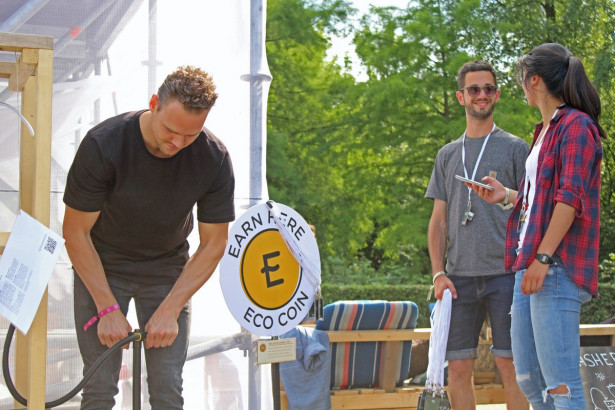
What's been your favorite case so far?
We had some really great results from the L’Oréal implementation. We did a pilot for them last year. It was fascinating because it was the first time we've gone so deep into corporate culture. I think it worked so well because there was already a very competitive atmosphere; they have several divisions, and are always striving to out compete each other. We played into that and grouped the leaderboards per division. That led to really high engagement. You could feel a buzz throughout the whole building, people joking at the coffee machines like ‘oh, how many do you have? I’m buying my coffee today with ECO coins’.
What challenges have you encountered in setting up ECO coin?
Part of it is regulations. The Dutch National Bank is currently passing new regulations on cryptocurrencies, which may limit our future ambitions. I think the challenge is also to get people to see another kind of value system. People really understand euros, because it’s money they've used all their lives. They don’t see the value of other kinds of money until they can actually spend it and get something from it. I would actually argue that we’re using multiple currencies every single day. We just don't think of them as currencies. Think of your loyalty points at a café, or topping up your public transport card. These are technically also tokens or currencies, designated to be used within a specific value system. The ECO coin represents a sustainable value system.
Another challenge we had mainly at the beginning was getting through to organizations to set up partnerships in the first place. Especially as a smaller start-up, it takes a lot of effort and work to connect with the decision makers of these organizations. Something that’s currently still difficult is getting smaller vendors on board for the reward system. Larger companies see it as value that will eventually flow back, and the publicity is often enough for them. We currently tend to pay smaller companies for their products, from the budget that the organization running the ECO coin puts in. We’re now trying to work through other token and business models, such as buy on get one free offers, to eventually move towards a completely self-sufficient system.
How do you see the ECO coin in 10 years?
We’re pretty ambitious. In ten years, we want it to be a genuine alternative system that you would use every day in Amsterdam. It will have become very normal that, when you tap in or tap out somewhere, you choose which currency you want to use – and for sustainable things you’ll be using your ECOs. The goal is also that eventually you’ll be able to exchange your ECO coins into euros, which would add a whole other layer of worth. We have a couple other ideas that we’re currently working out practically. Ideally, every ECO coin will be backed by a tree, just like every euro used to be backed by gold. This could also be a solar panel or wind farm – anything to give it intrinsic value and to double up the CO2 impact. We’ve recently started collaborating with a foundation on the Veluwe that owns 2 million trees, which is a first step in the good direction. We also want our currency to really be a ‘living coin’, meaning every coin will be programmed so that it gradually loses value over time. We do this partly because certain actions will hopefully become more normal and so worth less, but also largely because it drives people to actually go out and spend it. And you’ll be spending it on sustainable products or services, so that speeds up the whole cycle.
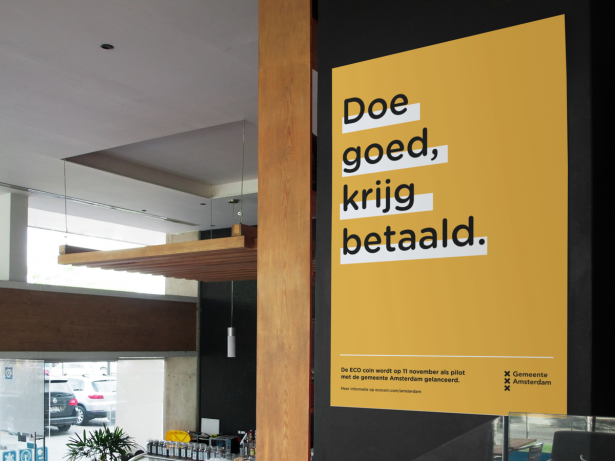
What would you recommend starters wanting to set up a sustainability-related company?
Go and connect with all of the amazing initiatives already out there and figure out where you fit within the bigger ecosystem. Transitioning to the circular economy is about joining multiple things up. You can’t work as an isolated company. It’s what I love about working in this field: traditional startups are constantly competing against each other, but as soon as you step into the sustainability world, everyone’s working towards the same goal and it can only be helpful to work together. It gives you a lot of energy.
-----------------------------------------------------------------------------------------------------
This interview series is a collaborative initiative of Metabolic,** AMS Institute, City of Amsterdam, Amsterdam Economic Board and Amsterdam Smart City. Working together within the Amsterdam Smart City platform, these organizations are committed to accelerate the transition to a circular economy.**
Circulaire Houtketens

Om te kijken hoe hout opnieuw en duurzaam gebruikt kan worden, zijn de provincie en Dr2 New Economy gestart met een aantal pilots waarin lokaal en gebruikt hout wordt toegepast in de bouw. Zo zijn 1.200 balken uit de busremise in Zaandam gesloopt en hergebruikt voor een nieuwe toepassing in de bouw.
Via een tweede pilot wordt gekeken hoe resthout als snoei-, tak-, top- en stamhout uit plantsoenen en parken van de stad, in de bouw hergebruikt kan worden. Bijvoorbeeld in de vorm van balken, planken of plaatmateriaal. Hout is een bekend en prachtig bouwmateriaal. Bij productie en verwerking is de CO2-uitstoot veel lager dan die van staal of beton. In het hout is juist veel CO2 vastgelegd, waarmee de woningen zorgen voor langdurige CO2 opslag.
Week of the Circular Economy #8: InStock

Instead of delicious food being thrown out, InStock redirects it onto a plate. In this interview, Freke van Nimwegen, founder of InStock, explains how they rescue fresh and healthy produce in the Netherlands from going to the landfill. With one-third of all the food in the world binned which was cultivated for consumption, it’s not just the food that’s wasted but the energy of farming, processing and transporting. This innovative initiative has set out to find solutions. They have their own restaurants serving rescued food, a marketplace for restaurants to buy fresh produce otherwise destined for the bin, and also offer beer and granola products made from ‘food waste’.
Here is an excerpt from this interview:
What can you tell me about the problem of food waste, how do you tackle it and how much food have you saved?
One-third of all food is wasted, and that happens mostly at the beginning and the end of the food chain. Right now at InStock we’re mostly focusing on the primary industry, so the food that is either at the farmers, producers, packaging companies or the broker. There is a lot of waste already before the retailer food companies even get it so we focus on their products that would be wasted otherwise, but are still perfectly fine. We then bring it to our restaurants as well as others to make sure it’s used. We have now saved close to 900,000 kilos from going in the bin.
What is the story of the InStock restaurants?
We started the restaurants in 2014 and our press release got so much attention we were fully booked immediately. We now have restaurants in 3 locations, one of them is in the political heart in Amsterdam which is great to create awareness, as politicians come to eat there. We have found really creative chefs who create lunch and dinner with whatever comes in. They used to have to make new recipes often, but over the years we’ve been able to establish a database of recipes to handle whatever comes in. For example, if beetroots come in we have a recipe for beetroot risotto which we can make for three weeks or three days depending on the quantity. We now have more and regular suppliers with larger quantities so we have a better prediction of what we are going to get. Also our creative chefs have come up with recipes that we have made a cookbook out of.
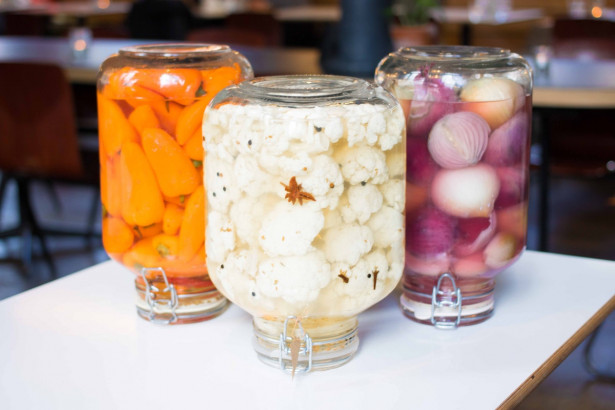
Could you tell me more about the beer and granola products that have been made from rescued food?
Because some products are wasted more than others we tried to see what we could use them for. So together with a local Amsterdam brewery, we made Pieper Bier from rescued potatoes and Bammetjes beer from rescued bread. From this collaboration we discovered that the grain which is left over after making beer at breweries, is still a very nutritious product with a lot of fibers and protein, so we use that as the base for our InStock Granola.
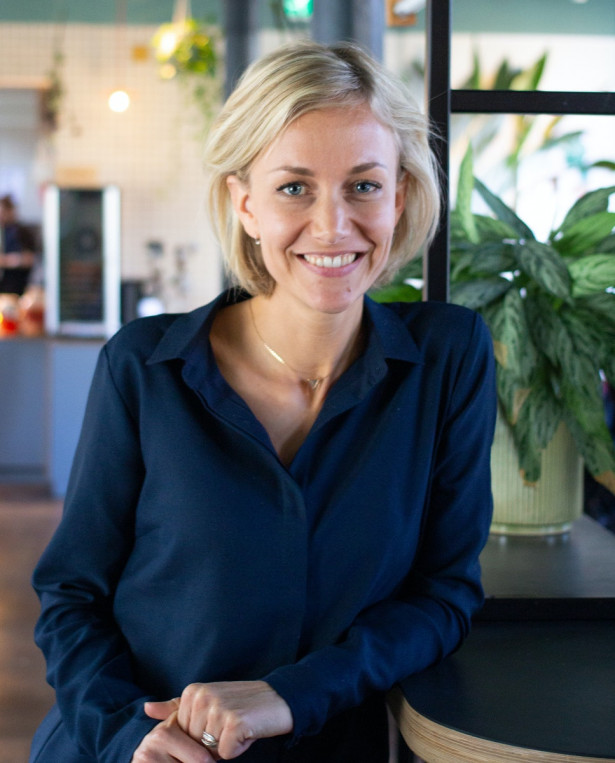
What do you think are the biggest barriers to getting more initiatives to use food waste?
In general, our whole system is based on a linear economy. The business case for a circular product is hard because it takes more time and money to get products that would be wasted otherwise. So, for example, it would have been cheaper for us in the beginning to just buy it at the wholesaler then what we were doing. But right now we're just seeing that as we are scaling up, with more suppliers and higher quantities delivering to InStock, then it becomes cheaper. It’s the same for packing and plastics, a lot of people want to work with recycled plastic but if it’s so much more expensive than normal plastic then why would they? Taxes could play a big role in this because now we are taxing income, but if we taxed resources then it would become a lot more interesting for companies to work towards circular business.
Could you tell me more about the ‘zero waste hierarchy’ and what you think are the best solutions?
The summary is to reduce, reuse, recycle, in that order. For us, of course, if you can prevent products or food from becoming waste, that’s better. After this, we reuse and recycle. If the food is not edible anymore then at least keep the value as high as possible. So for example, make compost out of it or animal feed from it instead of burning it or throwing it into the landfill.
<https://www.metabolic.nl/news/ready-to-stock-up-on-food-waste/>
Week of the Circular Economy #7: Circular textile industry
De textielindustrie is een van de meest vervuilende industrieën ter wereld. Textielproductie vervuilt rivieren, gebruikt overmatig water en chemicaliën en vindt plaats onder slechte werkomstandigheden. En dat alleen maar om onze kledingkast voor een zeer lage prijs te vullen.
Gelukkig zijn er heel erg veel hoopgevende initiatieven om het anders, beter te doen. Ook in de Metropool Amsterdam, zo vertelt Stef le Fèvre, van de gemeente Amsterdam. Wat gebeurt er al en hoe kunnen we impact maken?
Introduction meeting GO!-NH Accelerator Sustainable Innovation 2020

Introduction meeting GO!-NH Accelerator Sustainable Innovation 2020
With the help of these introduction meetings, you will get to experience the program and learn from participating teams about what the previous programs brought them.
February 10th 2020 - IDEA, Alkmaar - 15:30 - 18:00
Apply through Eventbrite: https://gonh2020-11feb.eventbrite.nl
ABOUT GO!-NH
The GO!-NH Accelerator puts SMEs and start-ups on the fast track to development. New ways of thinking, new skills and new partners are a must. This programme is all about circular economy, targeting sta-ups, innovative SMEs, large organisations and institutions. GO!-NH brings together all the relevant parties to activate, connect and develop this sustainable innovation ecosystem.
In a three-month programme you’ll go from concept to a business offering innovative solutions that’s ready to take the market by storm. Training sessions, tools and professional support from expert practitioners will help you in developing your business in a sheltered environment. The progress you make during these few months would normally take a full year. GO!-NH is a joint venture of the province of North Holland and Innomics.
The Accelerator program enables startups, innovative SMEs and innovation teams from large organizations to convert ideas into new business models in a short time and to accelerate customer and product development in order to shorten the time to market. You develop your business with training, tools and professional support from experts.
Introduction meeting GO!-NH Accelerator Sustainable Innovation 2020

Introduction meeting GO!-NH Accelerator Sustainable Innovation 2020
The GO!-NH Accelerator puts SMEs and start-ups on the fast track to development. New ways of thinking, new skills and new partners are a must. In a three-month programme you’ll go from concept to a business offering innovative solutions that’s ready to take the market by storm. Interested?
With the help of these introduction meetings, you will get to experience the program and learn from participating teams about what the previous programs brought them.
February 10th 2020 - IDEA, Alkmaar - 15:30 - 18:00
Apply through Eventbrite: https://gonh2020-10feb.eventbrite.nl
ABOUT GO!-NH
The GO!-NH Accelerator puts SMEs and start-ups on the fast track to development. New ways of thinking, new skills and new partners are a must. This programme is all about circular economy, targeting sta-ups, innovative SMEs, large organisations and institutions. GO!-NH brings together all the relevant parties to activate, connect and develop this sustainable innovation ecosystem.
In a three-month programme you’ll go from concept to a business offering innovative solutions that’s ready to take the market by storm. Training sessions, tools and professional support from expert practitioners will help you in developing your business in a sheltered environment. The progress you make during these few months would normally take a full year. GO!-NH is a joint venture of the province of North Holland and Innomics.
The Accelerator program enables startups, innovative SMEs and innovation teams from large organizations to convert ideas into new business models in a short time and to accelerate customer and product development in order to shorten the time to market. You develop your business with training, tools and professional support from experts.
Week of the Circular Economy #6: Loop.a life
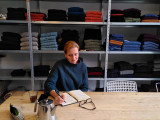
Throughout the week of the Circular Economy, we are shining a spotlight on inspiring sustainable initiatives in the Netherlands. Joining forces with startups, social entrepreneurs, creative professionals, leading companies, and forward thinking governments, to showcase what a circular economy can look like. Meet the pioneers, learn from them and get inspired! Next up: Ellen Mensink, founder of Loop.a life – possibly the world’s most circular sweater.
Throughout the week of the Circular Economy, we are shining a spotlight on inspiring sustainable initiatives in the Netherlands. Joining forces with startups, social entrepreneurs, creative professionals, leading companies, and forward thinking governments, to showcase what a circular economy can look like. Meet the pioneers, learn from them and get inspired! Next up: Ellen Mensink, founder of Loop.a life – possibly the world’s most circular sweater.
Ellen, what is the story of Loop.a life?
After my economics degree I went to the Rietveld Art Academy. There I loved to work with textiles. Later, in my work in all kinds of programs and innovation labs, I constantly missed a tangible end product. At some point I initiated the project ‘From Sheep to Shop’. My aim was to get wool – a beautiful and sustainable product, or so I believed – through the entire production process in a transparent way. That was somewhat disappointing, it turned out hard to trace. Around the same time, the Rana Plaza factory in Bangladesh collapsed. I found it unbelievable that we buy and wear clothing every day at far too low prices, while people on the other side of the world pay for it with their lives.
Waste was also a topic I’d always been intrigued in. I then started a research lab for sustainable fashion and waste in the textile chain. Recycling turned out to be the most logical way to go. I chose wool because it’s a strong and easily recyclable fiber, and there was a lot of potential to make its production chain more sustainable. A crowdfunding campaign showed that people really did want to invest their money in this kind of product, and actually liked the end result. Then it was just a matter of actually doing it: in 2016, I started Loop.a life and in October we launched our first collection during Dutch Design Week.
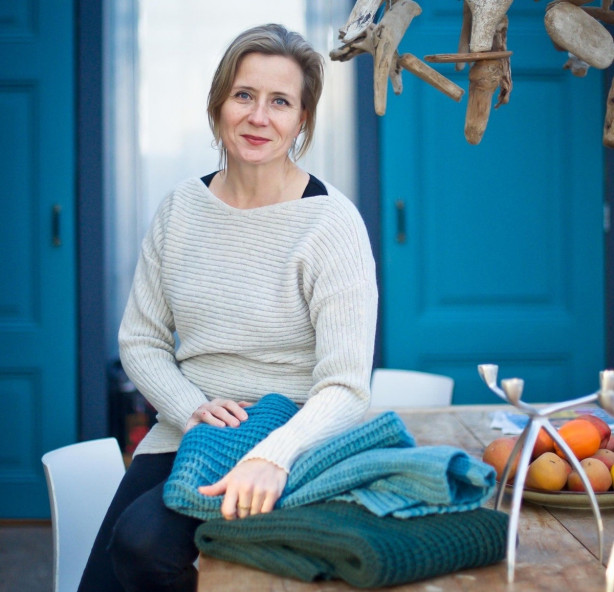
You’re known for your “truly circular” sweaters, please tell us more about that.
Our sweaters are 100% circular as our production process is closed-loop and completely in our own hands. We try to include sustainability in every aspect. We use as much postconsumer material as possible (up to 70%, mixed with industrial waste material and sometimes recycled pet for the color and strength of the yarn) and need no water or chemicals in the entire process. We only use fibers from locally worn jeans and sweaters, which have also been sorted here in Amsterdam. Our yarns and clothes are made strictly within European borders. This means far less transport than the usual route to South Asia, where clothing waste is usually recycled – only to be sent back to Europe to be turned into yarns, before again being sent to India or Bangladesh where the actual clothes are made! I think I can safely say that we have the most sustainable sweater in The Netherlands, possibly even in the world. At least that’s our ambition.
Can you measure your impact on the transition to a circular economy?
Yes, because we only work with our own production partners. All the data from the lifecycle analyses, such as the amount of water, energy and CO2 that goes into our sweaters, are on our website. Of course, what we actually want to know is how much it takes to make exactly 1 sweater; lifecycle analyses are still based on generic data in the industry. That’s what we will try to figure out this year, mainly by pushing our partners to dive deeper into their energy and water usage and truly question what is really necessary.
What has been the best moment in this process of establishing Loop.a life?
I’d say that was when we first started. With a group of students, we’d spent hours sorting heaps of old textile into different colors. All the arrangements with the production partner had been made, and we’d ambitiously ordered no less than 15 colors to start with. Only when the boxes finally arrived did it dawn on me: this is really happening, there’s no going back… but it couldn’t have been better: every single color turned out beautiful, it felt like walking through a candy shop!
Another exciting moment was more recently, when we decided to expand to cotton (from waste streams in the Netherlands). We’d chosen to work with a small spinning company in Italy. When we went there to finalize the collaboration, he’d already started spinning yarns – out of pure enthusiasm! It was amazing, this guy completely understood our mission and was very eager to help.
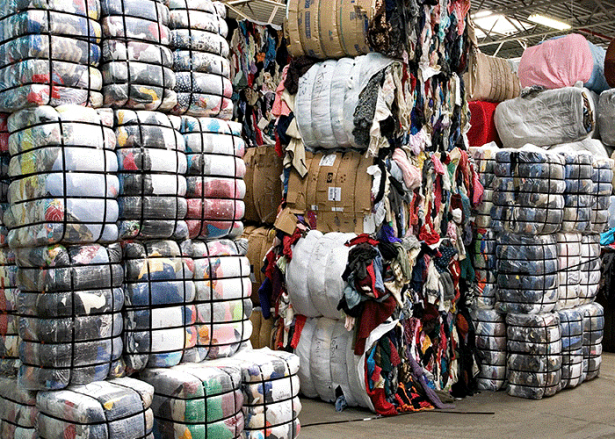
What are challenges you faced setting up Loop.a life?
The biggest challenge is being an ‘impact company’ and a start-up at the same time. Working with waste makes it even more complicated, because you’re really pioneering and have to examine every new waste stream or material. I also find collecting funding one of the hardest things, it’s constantly on my mind. Governmental subsidies for circular initiatives are often limited because it’s such an innovative field, which is a shame because these kinds of initiatives often have a lot of potential. They just don’t fit into the current system yet. We originally started out with crowdfunding, but currently depend mainly upon investors or organisations such as Stichting Doen. This can be just as hard. During a pitch I held at an accelerator project at Impact Hub I noticed that investors often have a ‘hockey stick’ mentality: as much revenue as possible, as quickly as possible. But the thing about being an impact company, especially one that focuses on a societal transition, is that you simply can’t let your revenue rise that quickly because you’re constantly developing and innovating behind the scenes. That makes it a lot harder to collect conventional investment funding.
What would be your advice to other starters that focus on the circular transition? How can you truly scale up?
Of course it always depends on what the specific business case and the materials you use. It helps to know clearly what you want to achieve and to have a clear vision. Most of all, though, I would say: collect as much money as possible from the start. It simply does not happen on its own. I always say: if this doesn’t work out I can always become a venture capitalist because I know so much about organising funds now… almost more than about textile!
What needs to change in the textile industry as a whole for it to become more circular?
The government could play a larger role. For example, it would make a tremendous difference if they lowered the value added tax (VAT) on products with a high percentage of postconsumer materials. That would make it more interesting for manufacturers to recycle. The government could also act as ‘launching customer’ for certain projects, that way assuring a certain level of demand and allowing for start-ups to experiment with new products. Generally, we’ve noticed that a lot of companies are interested in transitioning to a circular economy, but they simply don’t know where to start. They’re so used to just making sweaters, and it’s not in their production process to think about the waste that they also produce. It requires a whole different mentality in the textile industry.
What are you currently working on?
We’re trying to expand, and are currently looking at offering business gifts as well. This makes it easier to include our products in a Christmas bonus, for instance. In collaboration with Wieland Textiles, we’re also working on a new production line (the ‘Smart Fibersort’) to automate the process of sorting, cleaning and fiberizing postconsumer material. That way, we can hopefully turn local waste streams with postconsumer material into new high-quality material, focusing on the upcycling of postconsumer material in textile end products. We always say: beautiful materials deserve eternal life.

Any last words for ‘Amsterdammers’?
I would say: bring as much textile as you can to the textile containers so that it can be reused. Apart from that, support and buy from companies that truly work in a sustainable way and that look critically at the entire production chain. That way these impact companies can keep their little innovation engine running.
--------------------------------------------------------------------------------------------------------------
This interview series is a collaborative initiative of Metabolic, AMS Institute, City of Amsterdam, Amsterdam Economic Board and Amsterdam Smart City. Working together within the Amsterdam Smart City platform, these organizations are committed to accelerate the transition to a circular economy.
Develop your entrepreneurial skills as a volunteer! Make the Amsterdam centre more social and sustainable! Join us at BuurtBuik!
BuurtBuik is all about sharing food with your neighbors. We cook meals from food that would be wasted otherwise. Thereby, bringing people together around a free three course meal and build their social network. It impacts both environmental and social goals, thus, bridging the gap to a circular social economy. We would like to expand by setting up a new location in the Centre of Amsterdam. Are you going to be part of the team of volunteers that is going to make this happen? Is your Dutch at working knowledge level? To get more more information or to apply (before 4 March '20): visit our website buurtbuik.nl
Week of the Circular Economy #4: the Zwerfinator

Throughout the week of the Circular Economy, we are shining a spotlight on inspiring sustainable initiatives in the Netherlands. Joining forces with startups, social entrepreneurs, creative professionals, leading companies, and forward thinking governments, to showcase what a circular economy can look like. Meet the pioneers, learn from them and get inspired! Next up is Dirk Groot. Profession: superhero - fighting litter and plastic soup with his Zwerfinator movement.
Throughout the week of the Circular Economy, we are shining a spotlight on inspiring sustainable initiatives in the Netherlands. Joining forces with startups, social entrepreneurs, creative professionals, leading companies, and forward thinking governments, to showcase what a circular economy can look like. Meet the pioneers, learn from them and get inspired! Next up is Dirk Groot. Profession: superhero - fighting litter and plastic soup with his Zwerfinator movement.
So, Dirk, can you tell us about the Zwerfinator?
My personal mission is the battle against litter. I do that by: i) cleaning up, ii) educating people & creating awareness; iii) and most importantly: conducting research. I conduct research by collecting data on litter: what is it, where did I find it and how does this match with the surroundings. Based on the collected data I advise local governments and companies and help them with finding solutions.
I am a data scientist by heart. So I know a lot about data: how to collect, interpret and advise on this data. I started 6 years ago with picking trash and 3.5 years ago with collecting the data.
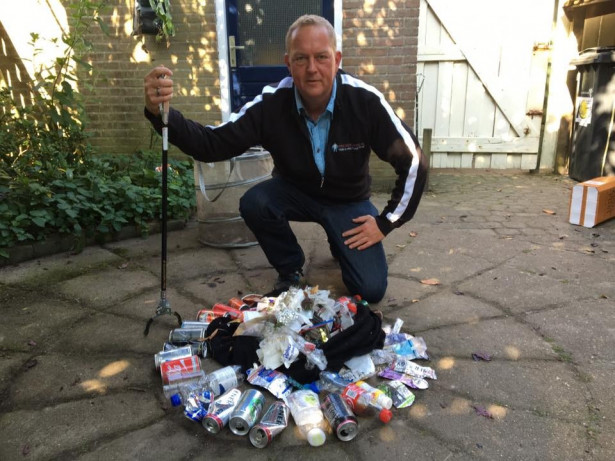
And how do you collect this data?
I use an app: Litterati. This app allows me to upload pictures of every piece of litter I pick up. Besides the picture I add extra data like: what it is, what kind of material, what kind of brand, the exact geo-location, and some extra details. You can see on the map where there is a lot of litter found and see if you can discover certain tracks. It is even possible to find the origin of the litter, for example, is there a company or store that produces a lot of litter? You can see this in the data collected. With this data I can signal to the company that they produce a lot of litter. Together we can try to find solutions like: reducing the amount of packaging or looking at the production of packages, is it possible to use organic materials.
But not only the places that have a lot of litter are valuable: it is also valuable to examine the really clean parts of the city.
How many people are collecting the data?
I see a shift: there is a growing number of people collecting data while picking up trash. I think people are fed up by picking up the same amount of trash, time after time, and they see the value of collecting the data for formulating solutions. It’s a new kind of volunteer work and the plus side is: you can do it anywhere, at any time. If you have an hour to spare, it is sunny, you can just go outside and contribute. In the Netherlands we have about 300 active users of the app, we have the most active members in the world. Worldwide there are about 4,700,000 pieces of litter picked up.
Can you give an example where the collected data made impact?
In June 2018, I started a campaign to create awareness about the commonly found litter, Antaflu wrappers. I encouraged other people to collect and tag these pieces of litter correctly. In total over 30,000 data points are collected now. With this information I teamed up with Merijn Tinga (the Plastic Soup Surfer) and we visited the CEO of Pervasco (the producer of Antaflu candy) in Rotterdam and he decided to change the packaging from plastic to paper, a more organic material.
After this successful campaign, we decided to start a second campaign to pass a policy that bans manufacture and sale of the Knetterbal Firecrackers. (also known as Crackling Balls) We started a movement that managed to pick up and tag over 50,000 littered plastic shells of these firecrackers in two months. After collecting and publishing this information, HEMA and the Albert Heijn decided to ban the sale of these firecrackers. This created a ripple effect inspiring 7 other retailers to remove Knetterbals from their shelves. Great to see that a campaign led to direct results.
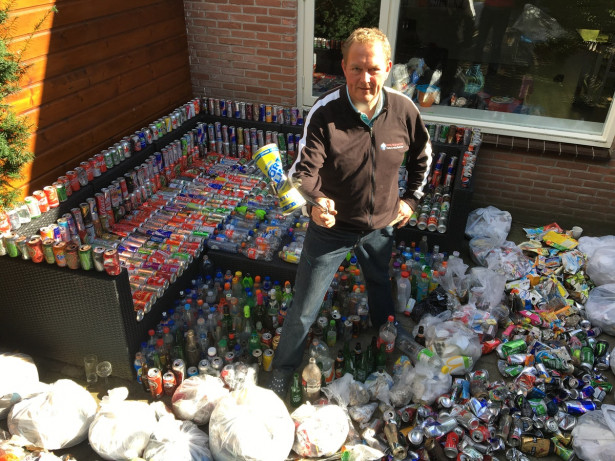
Looking at the future, what will be the next step? What do you need to make your impact even bigger?
I work according to the Forest Gump principle. Do you know what this is? This means that if I have an idea, I start to run with it, just like in the movie. I started alone with an idea to collect data surrounding litter. I talked to a bunch of people, but no one really believed that it could make impact. But I was convinced that it could make a difference. That’s why I just started and run with the idea. Now 3.5 years later the impact and results are tangible and people finally see and appreciate the added value.
Normally you see people having an idea and start looking for investors. For me it works the other way around: I have an idea or hunch and start with the implementation immediately. The rest will follow later.
But the campaigns I did together with Merijn are really successful and I like to do more of those in the future. We’re a good team. He is good in the lobbying and campaigning aspect and I can activate the community of litter pickers to collect the data. Next thing on the agenda is the ‘Plastic Avengers’ conference in Blue City, Rotterdam. Bringing all those individuals battling the plastic or litter problem together. So that they can collectively find concrete and tangible solutions for these challenges. For example in a Hackaton or something else.
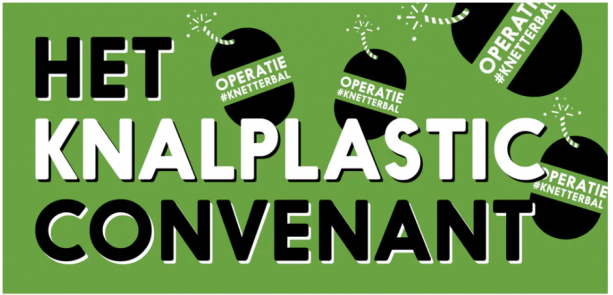
What do you think could be done in your industry to accelerate the transition to a circular economy?
I think there are three important things that I want to mention. First, there needs to be a deposit on all drinking packages. Even everything that has a lid or cap. No exceptions. And making sure it is made of recyclable material. There needs to be some sort of economic incentive for people to take recycling seriously. Second, circular economy can also exist in nature. Not everything has to be recycled for humans. It can also be recycled for nature or animals. Of course with the exception of synthetic materials. Third, we can learn a lot of how people used to live. During and after the war, people lived in scarcity. No food was wasted and what could be reused, was reused. For example, my parents owned a bakery and nothing was spilled: from old or broken pastries we made different, new products. If everyone will live by this mindset, the transition to a circular economy is possible.
-----------------------------------------------------------------------------------------------------------
This interview series is a collaborative initiative of Metabolic, AMS Institute, City of Amsterdam, the Amsterdam Economic Board and Amsterdam Smart City. Working together within the Amsterdam Smart City platform, these organisations are committed to accelerate the transition to a circular economy.
Looking for interviewees to support the development of a new citizen engagement strategy for circular transitions
Hey everyone!
As a graduation project, I'm researching citizen engagement strategies in circular transitions. My goal is to develop a new citizen engagement strategy. To gain insights in the needs and wants, I want to interview citizens and organisations that are engaged in circularity challenges.
If you're interested in supporting this research by letting me interview you, or just curious about the results, feel free to contact me!
Best regards,
Lotte
Week of the Circular Economy #3: Building bridges from flushed toilet paper
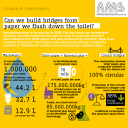
Imagine biking over a bridge made out of paper we flush down the toilet in the City of Amsterdam? Every year, up to 175.000.000kg of cellulose-rich toilet paper can be sieved by wastewater treatment plants in the Netherlands. What if valuable resources like the aforementioned could be re-used by the construction sector?
Currently, BAM Infra Nederland, NPSP, Technische Universiteit Delft, ChainCraft B.V. and our Research Fellow Peter Mooij investigate how a "bulletproof" bio-based 100% circular material - from combining cellulose and bacterial glue extracted from wastewater - can be best applied by the construction sector. Click here to read the full article: https://www.ams-institute.org/news/can-we-build-bridges-paper-we-flush-down-toilet/
Permaculture Impact on Schools, Europa School Transformation
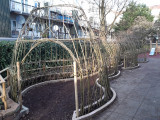
Our children are growing on paved, 2 dimentional and disconnected school environments. We are here to change that. With our passion Permaculture concept, we designed and created a new style of school garden, which doesn't exist in Amsterdam and if we are not wrong in the Netherlands. It was not the first of our school design/implementation. Laterna Magica School in IJburg Amsterdam is also another example.
You can find further info, photos, videos on our website. We need help from all aware people to inform schools about our services that we can have more impact on our environment and children's connection with nature
Week of the Circular Economy #2: Program Circular Mattresses
Matrassen zijn de grootste stroom binnen het huishoudelijk restafval. Elk jaar danken we er meer dan een miljoen af. Dat is de Johan Cruijff ArenA tot het dak gevuld. Waarom verbranden als we het ook kunnen recyclen?
Ons initiatief Circular Economy Lab in samenwerking met Utrecht Sustainability Institute was het startschot voor de nationale coöperatie in de matrasketen. Onder leiding van Jacqueline Cramer en Jan Nieuwenhuis werken we toe naar een circulaire matrasketen.
Week of the Circular Economy #1: Upcyclecentre Almere
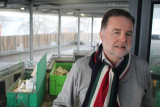
Throughout the week of the Circular Economy, we are shining a spotlight on inspiring sustainable initiatives in the Netherlands. Meet the pioneers, learn from them and get inspired! First up is Henk Martens: Programme Manager of the Upcyclecentre in Almere.
Throughout the week of the Circular Economy, we are shining a spotlight on inspiring sustainable initiatives in the Netherlands. Joining forces with startups, social entrepreneurs, creative professionals, leading companies, and forward thinking governments, to showcase what a circular economy can look like. Meet the pioneers, learn from them and get inspired! First up is Henk Martens: Programme Manager of the Upcyclecentre in Almere.
So, Henk, can you tell us what the Upcyclecentre is all about?
The Upcyclecentre contributes to a circular economy in which raw materials are reused optimally. Residents bring in their waste, and startups on site design and create products from the waste. Old goods gain new economic value, value which in some cases may be higher than the original value. It’s a new concept; people may say it’s the first upcycle centre in Europe. Almere wants to show residents, companies, and other cities that it is possible. But it’s much more than this: the building itself is designed to be circular, with recycled materials. We have 276 solar panels on the roof, and we can collect and reuse rainwater for the toilets. And much more importantly we want to inspire visitors to think and act with a circular mindset. This year we even started offering an educational program for schools.
Every year Almere records 400.000 unique visitors at the waste points.

What kind of startups are on site?
We just had the first batch of startups. Ruig & Geroest makes interior designs, like lamps, from trash, Ruik makes perfume from pine needles or orange peels, & Seefd saves and screenprints pre-loved clothes. The Upcyclecentre gives these circular startups the chance to develop their business cases by offering them a workspace, giving them a small startup capital of €5.000, and helping them with collecting the right used materials. In exchange, the startups have to share the message of circularity and stimulate circular behavioral change by giving workshops to residents, children etc. Now we are looking for the second batch of startups: there is a time constraint on how long the startups can remain on site, to give the opportunity to other circular entrepreneurs, further accelerating the transition to a circular economy. It’s sort of like an incubator program. But the City of Almere still offers the opportunity to join a circular hub district.
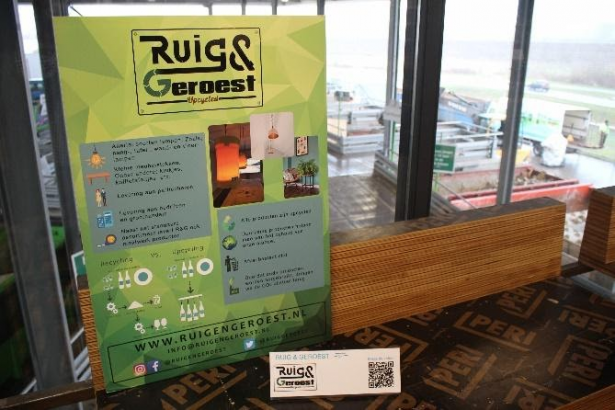
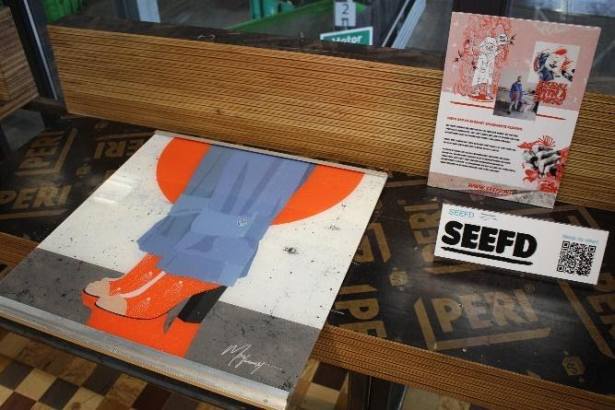
You briefly mentioned that this is the first Upcyclecentre of Europe. Why do you think this hasn’t happened before?
Coincidence or not, Almere is hosting the International Horticultural Expo in 2022: the Floriade. The theme is ‘Growing Green Cities’ and the expo will focus on the green city of the future with growing cities: in 2050 more than 70% of people will live in cities. This created a momentum to do things differently, develop this center and create a showcase for the Expo. It wasn’t easy and it is not something you can do by yourself. The City of Almere collaborated together with the Omgevingsdienst, the Province of Flevoland and the Ministry of Economics & Climate to make this idea into reality.
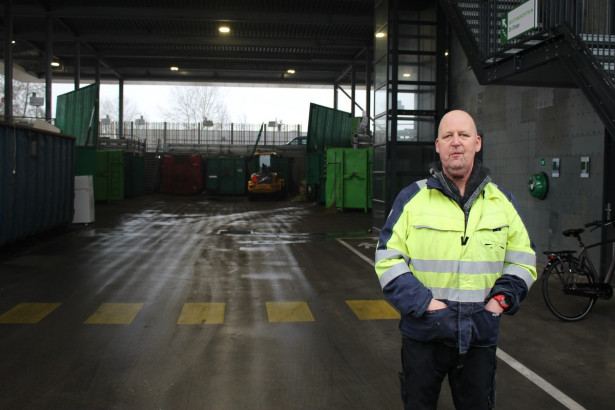
What do you think are the biggest barriers and challenges the Upcyclecentre is facing?
It’s a difficult question. We are really in the start-up phase. 2020 will be the year to prove that the Upcyclecentre has the right to exist and we will focus on measuring the impact we’ve created towards a circular economy. One challenge is the involvement of residents, even more. Or finding the right startups to join the incubator program on site.
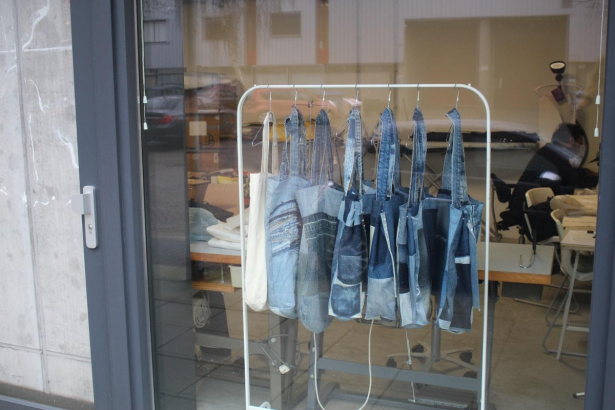
The City of Amsterdam organized a market exploration for a potential Upcyclecentre in Amsterdam North. Do you have any learnings or recommendations for them?
First of all, it is super important to start this initiative with a group of highly motivated people. People who are intrinsically motivated to make this a success. People who believe in the story and want to be an ambassador for the Center. Secondly don’t underestimate the power of good marketing and communication. You want to do this not only for, but also with, the residents of the city. You want to use this center to involve and inspire residents to make this transition to a circular economy happen. This means involving the residents from the start and also reducing potential barriers for users of the center. Make residents your ambassadors as well.
What do you think could be done in your industry to accelerate the transition to a circular economy?
It’s important to show the world that it is possible;a positive outlook on the circular economy. A can-do mentality. That’s what we want to accomplish with the Upcyclecentre. Set an example for the rest of the world and show something concrete and tangible. The city government can take a leading role in this as well. The City of Almere’s initiative is a good example for this.

And if we are looking into the future, where is the Upcyclecentre in 5, 10 or maybe even 20 years?
In a dream scenario all stakeholders have a circular mindset: companies, government, educational organizations and residents. But it’s going to be difficult. The first step is relatively easy: mobilizing the frontrunners. The next step is going to be harder: mobilizing the masses. But with the arrival of the new Account Manager, Hede Razoky, the first step in the right direction is made!
-----------------------------------------------------------------------------------------------------------
This interview series is a collaborative initiative of Metabolic, AMS Institute, City of Amsterdam, the Amsterdam Economic Board and Amsterdam Smart City. Working together within the Amsterdam Smart City platform, these organisations are committed to accelerate the transition to a circular economy.
Week of the Circular Economy | Meet the pioneers, learn from them and get inspired!
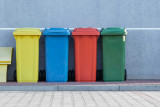
Throughout the week of the Circular Economy, we are shining a spotlight on inspiring sustainable initiatives in the Netherlands. Joining forces with startups, social entrepreneurs, creative professionals, leading companies, and forward thinking governments, to showcase what a circular economy can look like. Meet the pioneers, learn from them and get inspired!
Welcome to the Dutch week of the Circular Economy! Throughout the week, we will be shining a spotlight on inspiring sustainable initiatives in and around the Amsterdam area, by sharing interviews with pioneering projects and companies who are showing tangible solutions to take us from a linear to a circular economy.
Read about startups, social entrepreneurs, creative professionals, leading companies, and forward thinking governments, and learn what a circular economy can look like. We will be publishing 2 articles each day. So, stay tuned!
This interview series is a collaborative initiative of Metabolic, AMS Institute, City of Amsterdam, the Amsterdam Economic Board and Amsterdam Smart City. Working together within the Amsterdam Smart City platform, these organisations are committed to accelerate the transition to a circular economy.
More information about this week: https://deweekvandecirculaireeconomie.nl/
#circulareconomy #WeekvandeCE
Read all the interviews here:
#1 Upcyclecentre Almere
#2 Program Circular Mattrasses
#3 Building bridges from flushed toilet paper
#4 The Zwerfinator
#5 Getting buy-in for products-as-a-service
#6 Loop a.life
#7 Circular Textile Industry
#8 InStock
#9 ECO Coin
Top 5 Solutions for the Decade
Moving into the new decade, these are the top 5 solutions to greening the economy, lowering emissions, and enhancing resilience to climatic extremes.
Stay up to date
Get notified about new updates, opportunities or events that match your interests.

